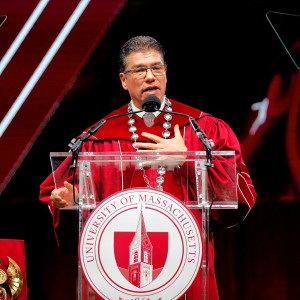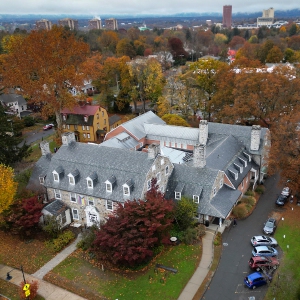With climate education, Hitchcock Center looks to help children envision ideal world
| Published: 01-04-2023 8:54 PM |
WHATELY — While winter’s warmest days remind us that our climate’s future could be bleak, the future generation reminds us that it may not have to be.
Stephanie Apanell’s fourth grade class at Whately Elementary School joined forces with Amherst’s Hitchcock Center for the Environment this October for a series of climate-related explorations. Students engaged in hands-on activities over the course of three sessions at Whately Elementary, as well as during one visit to the Hitchcock Center. Monya Relles, the Hitchcock Center’s environmental educator who headed the program, said she primed her lessons to make climate-related education about more than “just being hopeless.”
“In my personal work, I keep coming back to (climate activist and writer) Adrienne Maree Brown who said all climate education is science fiction,” Relles said. Climate education is “inherently revolutionary,” centered on envisioning an idealistic world that has yet to exist, she elaborated.
And what better catalyst for the revolution than a child’s imagination, she reasoned.
“In broad strokes, I think key pieces of teaching children about climate change is to be hopeful and ... to be solution-oriented,” she said. “I think students thinking about themselves as problem-solvers is really important.”
Relles’ lesson plans revolved around “deconstructing the idea that nature is somewhere.” Rather, nature is everywhere, she argued. At Whately Elementary, she introduced students to a confluence of human innovation and the natural world: “solar panels we can play with.” Working within “the language of engineering and of problem solving,” the children were presented with real voltmeters, circuits and other related paraphernalia to expose them to “what’s actually getting done” to preserve the climate.
“A really key piece is not telling them how to feel and letting them come to their own conclusions,” Relles said.
Aside from being “a place to dream and feel hopeful,” the Hitchcock Center facility delivered a lesson merely by existing as a “living building,” or a self-sustaining structure that operates and is dependent on natural cycles, such as rainfall. Additionally, staff gave visiting students insight into how career actuarial architects and engineers think, Relles recapped. After a tour of the center, the children were tasked with drawing something beautiful they observed before shifting gears to redesigning wind turbines.
Article continues after...
Yesterday's Most Read Articles
 Granby Bow and Gun Club says stray bullets that hit homes in Belchertown did not come from its range
Granby Bow and Gun Club says stray bullets that hit homes in Belchertown did not come from its range
 Super defers Amherst middle school principal pick to successor; one finalist says decision is retaliation for lawsuit
Super defers Amherst middle school principal pick to successor; one finalist says decision is retaliation for lawsuit
 Political newcomer defeats Shores Ness for Deerfield Selectboard seat
Political newcomer defeats Shores Ness for Deerfield Selectboard seat
 ‘Home away from home’: North Amherst Library officially dedicated, as anonymous donor of $1.7M revealed
‘Home away from home’: North Amherst Library officially dedicated, as anonymous donor of $1.7M revealed
 Town manager’s plan shorts Amherst Regional Schools’ budget
Town manager’s plan shorts Amherst Regional Schools’ budget
 Annette Pfannebecker: Vote yes for Shores Ness and for Deerfield
Annette Pfannebecker: Vote yes for Shores Ness and for Deerfield
Relles feels “incredibly lucky to be a teacher working outside of public schools and working with pieces that can sort of supplement” a rigid state curriculum.
“If you look at the state standards for science … it specifically says it does not include climate change,” Jeanne Powers, director of teaching and learning for the Gill-Montague Regional School District, said of Massachusetts’ curriculum at the elementary level. “I think the foundational skills they learn … allow for more complex thinking about climate in the older grades, so I think it’s a good progression.”
“For instance, in third grade, students study Earth and space, including climate data about temperature and rainfall, and summarize weather conditions of different regions,” explained Karin Patenaude, assistant superintendent of teaching and learning with the Greenfield School Department.
Exposing children to climate education early on in their school years is paramount to fostering optimism in the midst of widespread negativity, Relles argued. Commonly in society, she observed, climate rhetoric implies that human beings are inherently a negative influence on the world in which they live. Relles said she hopes children recognize through her lessons that people can serve the opposite purpose, and even reverse the course of climate change if they act quickly.
“I think the biggest challenge is trying to shift that identity,” she said.
Climate Change at Home is presented by Whalen Insurance.

 Sharing a few notes: High schoolers coaching younger string players one on one
Sharing a few notes: High schoolers coaching younger string players one on one Reyes takes helm of UMass flagship amid pro-Palestinian protests
Reyes takes helm of UMass flagship amid pro-Palestinian protests Sole over-budget bid could doom Jones Library expansion project
Sole over-budget bid could doom Jones Library expansion project Amherst poised to hire police department veteran as new chief
Amherst poised to hire police department veteran as new chief 